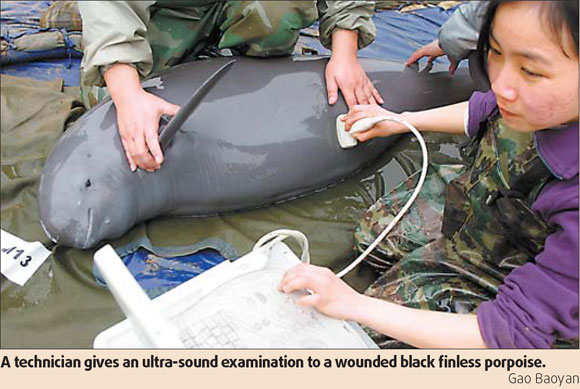Researchers hope DNA tests will shed light on rare porpoises

Scientists will conduct DNA testing on 22 black finless porpoises at the Tian'ezhou Nature Reserve in Shishou, Hubei province, in the hope of shedding some light on the breeding practices of the rare species.
The results of the test should be available within a year, according to the Wuhan-based Changjiang Commercial News.
Researchers have already collected blood samples from 22 black finless porpoises, including five pregnant ones, the paper reported.
The move marks the first time provincial officials have conducted DNA paternity tests for such a large group of porpoises.
Generally, between two and four black finless porpoises are born each year at the Tian'ezhou Nature Reserve, which is home to more than 30 of the aquatic mammals.
"We are very interested in studying whether they engage in inbreeding," Wang Ding, deputy head of the Institute of Hydrobiology of the Chinese Academy of Sciences, said.
He said the porpoises might have a special system to help avoid inbreeding.
Previous studies of finless porpoises have yielded no proof of inbreeding, Wang said.
Meanwhile, staff at the nature reserve will also be expanding their monitoring of the porpoises to learn more about how they live.
They decided to widen surveillance after 22 black finless porpoises were found injured, some of them fatally, at the center since the end of last month.
Among the four that have died, two were female and one was pregnant. A 1.57-m-long pregnant porpoise was found dead at the end of last month, its body covered with scratches. The other three porpoises also had abrasions and wounds. All four also had signs of severe frostbite.
Shards of broken ice in the Yangtze River were believed to be the culprits, according to a Xinhua News Agency report.
Experts said that it appeared the animals sustained cuts from the ice. The wounds became infected and ultimately caused their deaths.
The river froze over during the severe weather this winter. Porpoises are mammals and must have access to the air to breathe. When the river froze over, workers at the preserve broke the ice to allow the them to surface.
A group of experts arrived at the Tian'ezhou Nature Reserve on April 3 to help treat the wounded, giving them anti-inflammatories and medicine for their wounds.
Finless porpoises, like white-flag dolphins, are rare mammals native to the Yangtze River, China's longest, and its numerous lakes. However, the dolphin is considered "functionally extinct" and an international expedition in November and December 2006 failed to find a single specimen.
Between 1,200 and 1,400 finless porpoises now inhabit the Yangtze River, Poyang Lake and Dongting Lake.
Those figures are less than half the total recorded in the early 1990s. Excessive development along the Yangtze River in the past years has been blamed for wiping out the species.
The 20-km-long Tian'ezhou Nature Reserve began to feed finless porpoises in 1992.
(China Daily 04/09/2008 page6)














